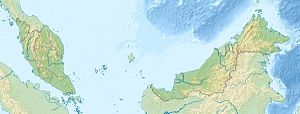Pulau Gaya
| Pulau Gaya | ||
|---|---|---|
| East coast of the island with the dwellings of immigrants | ||
| Waters | South China Sea | |
| Geographical location | 6 ° 1 '5 " N , 116 ° 2' 7" E | |
|
|
||
| length | 8 kilometers | |
| width | 3.3 km | |
| surface | 15 km² | |
| Highest elevation | 300 m | |
| Residents | 500 (2005) 33 inhabitants / km² |
|
| main place | Kampung Pulau Gaya | |
Pulau Gaya ( English Gaya Island ) is an island belonging to Malaysia in the South China Sea west of Borneo . It is located about two kilometers off the coast, separated by the South Channel , and belongs to Kota Kinabalu in the Malaysian state of Sabah .
Origin of name
The name of the island is borrowed from the Bajau language. The word goyoh means big here . Pulau Gaya is the "Big Island".
history
The North Borneo Chartered Company established its first administrative headquarters on Pulau Gaya in September 1882 with the primary aim of using it as a collection point for jungle products and local goods. The island had already been acquired on December 29, 1877 along with other smaller territories on the west coast on the basis of a treaty with the Sultan of Brunei.
The settlement suffered from a lack of water from the start. As early as 1885 voices were heard calling for the station to be relocated to the mainland. After the port and administration buildings were destroyed and looted on July 9, 1897 during the Mat Salleh Rebellion , the company relocated its administration buildings to the nearby mainland, initially to Gantian. Because some of the men in Mat Salleh's retinue came from the Inanam, Menggatal and Mengkabong region, the Chartered Company sought damages from the Sultan of Brunei, who ruled the region at the time. The Sultan ceded other areas of the mainland to the society, including Menggatal, Mengkabong, Api Api, Sembulan, Inaman, Kuala Lama and Mebakut, to replace the goods worth 100,000 Straits dollars stolen from Gaya.
geography
The island extends over an area of 15 square kilometers. Individual elevations on the island reach a height of up to 300 meters. Before the Ice Age, the island was part of the mountain range of the Crocker Ranges, as shown by the composition of the sandstone and sedimentary rock layers on the island. The rising sea levels at the end of the Ice Age about a million years ago cut off part of the land mass and formed the islands of Gaya Island, Sapi Island, Manukan Island, Mamutik Island and Sulug Island.
In 1923 the forest of Pulau Gaya was placed under protection. In 1974, most of the islands of Pulau Gaya and Pulau Sapi were incorporated into the Tunku Abdul Rahman National Park .
There are five villages on the island; Kampung Kesuapan, Kampung Pulau Gaya, Kampung Pondo, Kampung Lok Baru and Kampung Urai.
As part of the Tunku Abdul Rahman National Park, the waters around Pulau Gaya are suitable for scuba diving .
Stilt houses
Most of the Filipinos who immigrated illegally to Kota Kinabalu live in the stilt houses of the Filipino colony Kampung Lok Urai . In addition to the illegals, members of the Bajau and Ubian also live in the colony, many of whom work in the low-wage sector in Kota Kinabalu. The pile dwellings are connected by catwalks. The sanitary conditions of the uncontrollably expanding "floating village" are correspondingly catastrophic. The colony is avoided by the locals and the police. In the past there have been various attempts to evict the illegals.
literature
- "From Gaya to Jesselton" in: Danny Wong Tze Ken Historical Sabah: Community and Society , Natural History Publications (Borneo) Sdn. Bhd, Kota Kinabalu, 2004, ISBN 983-812-090-1
Individual evidence
- ^ Danny Wong Tze Ken, page 1
- ^ Danny Wong Tze Ken, page 5
- ↑ Sabah Parks: Activities ( Memento of the original from March 13, 2014 in the Internet Archive ) Info: The archive link was inserted automatically and has not yet been checked. Please check the original and archive link according to the instructions and then remove this notice. ; Accessed March 12, 2014
- ^ A home away from home for many Filipinos ; Accessed January 15, 2012
- ↑ Sabah seeks to remove thousands of illegal immigrants from Pulau Gaya ; Accessed January 15, 2012
Remarks
- ↑ Sultan of Brunei at that time was Sultan Abdul Mumin Ebn Marhoum Maulana Abdul Wahab.


